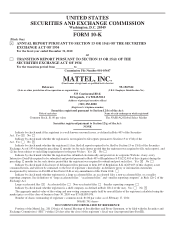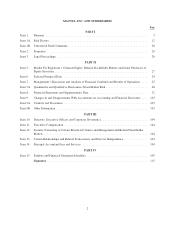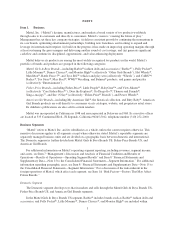Mattel 2010 Annual Report Download - page 16
Download and view the complete annual report
Please find page 16 of the 2010 Mattel annual report below. You can navigate through the pages in the report by either clicking on the pages listed below, or by using the keyword search tool below to find specific information within the annual report.Justice League®, Speed Racer®, and Green Lantern®), Sesame Workshop®through December 31, 2010 (relating
to its Sesame Street®properties including Elmo™), WWE®Wrestling, and HIT Entertainment™ relating to its
Thomas and Friends®properties.
Royalty expense for 2010, 2009, and 2008 was $245.9 million, $188.5 million, and $241.2 million,
respectively. See “Commitments” and Item 8 “Financial Statements and Supplementary Data—Note 14 to the
Consolidated Financial Statements—Commitments and Contingencies.”
Mattel also licenses a number of its trademarks, characters, and other property rights to others for use in
connection with the sale of non-toy products that do not compete with Mattel’s products. Mattel distributes some
third-party finished products that are independently designed and manufactured.
Trademarks, Copyrights and Patents
Most of Mattel’s products are sold under trademarks, trade names, and copyrights, and a number of those
products incorporate patented devices or designs. Trade names and trademarks are significant assets of Mattel in
that they provide product recognition and acceptance worldwide.
Mattel customarily seeks patent, trademark, or copyright protection covering its products, and it owns or has
applications pending for US and foreign patents covering many of its products. A number of these trademarks
and copyrights relate to product lines that are significant to Mattel’s business and operations. Mattel believes its
rights to these properties are adequately protected, but there can be no assurance that its rights can be
successfully asserted in the future or will not be invalidated, circumvented, or challenged.
Commitments
In the normal course of business, Mattel enters into contractual arrangements for future purchases of goods
and services to ensure availability and timely delivery, and to obtain and protect Mattel’s right to create and
market certain products. Certain of these commitments routinely contain provisions for guarantees or minimum
expenditures during the term of the contracts. Current and future commitments for guaranteed payments reflect
Mattel’s focus on expanding its product lines through alliances with businesses in other industries. Additionally,
Mattel routinely enters into noncancelable lease agreements for premises and equipment used in the normal
course of business.
Purchase and service agreements with terms extending through 2015 and beyond contain future minimum
payments aggregating approximately $445 million. Licensing and similar agreements with terms extending
through 2015 contain provisions for future guaranteed minimum payments aggregating approximately
$251 million. Lease commitments with terms extending through 2015 and beyond contain future minimum
obligations aggregating approximately $546 million. See Item 7 “Management’s Discussion and Analysis of
Financial Condition and Results of Operations—Commitments” and Item 8 “Financial Statements and
Supplementary Data—Note 14 to the Consolidated Financial Statements—Commitments and Contingencies.”
Backlog
Mattel ships products in accordance with delivery schedules specified by its customers, which usually
request delivery within three months. In the toy industry, orders are subject to cancellation or change at any time
prior to shipment. In recent years, a trend toward just-in-time inventory practices in the toy industry has resulted
in fewer advance orders and therefore less backlog of orders. Mattel believes that the amount of backlog orders at
any given time may not accurately indicate future sales.
Financial Instruments
Currency exchange rate fluctuations may impact Mattel’s results of operations and cash flows. Mattel seeks
to mitigate its exposure to market risk by monitoring its foreign currency transaction exposure for the year and
partially hedging such exposure using foreign currency forward exchange contracts primarily to hedge its
8
























